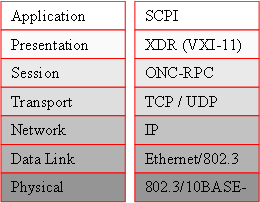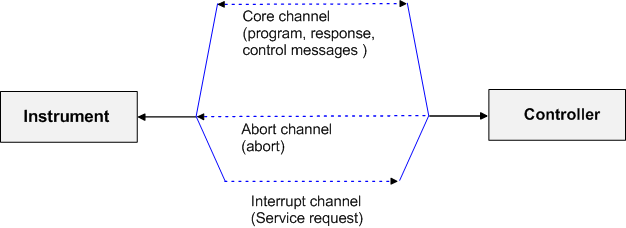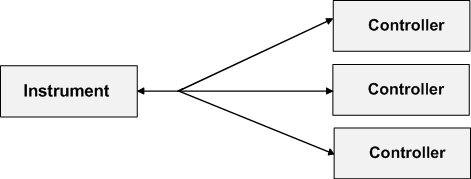
The VXI–11 standard is based on the RPC protocol which in turn relies on TCP/IP as the network/transport layer. The TCP/IP network protocol and the associated network services are pre-configured. TCP/IP ensures connection–oriented communication, where the order of the exchanged messages is adhered to and interrupted links are identified. With this protocol, messages cannot be lost.
Remote control of an instrument via a network is based on standardized protocols which follow the OSI reference model (see Fig. below).

Based on TCP/UDP, messages between the controller and the instrument are exchanged via open network computing (ONC) – remote procedure calls (RPC). With XDR (VXI–11), legal RPC messages are known as VXI–11 standard. Based on this standard, messages are exchanged between the controller and the instrument. The messages are identical with SCPI commands. They can be organized in four groups:
Program messages (control command to the instrument)
Response messages (values returned by the instrument)
Service request (spontaneous queries of the instrument)
Low–level control messages (interface messages)
A VXI–11 link between a controller and an instrument uses three channels: core, abort and interrupt channel. Instrument control is mainly performed on the core channel (program, response and low–level control messages). The abort channel is used for immediate abort of the core channel; the interrupt channel transmits spontaneous service requests of the instrument. Link setup itself is very complex. For more details refer to the VXI–11 specification.

The number of controllers that can address an instrument is practically unlimited in the network. In the instrument, the individual controllers are clearly distinguished. This distinction continues up to the application level in the controller, i.e. two applications on a computer are identified by the instrument as two different controllers.

The controllers can lock and unlock the instrument for exclusive access. This regulates access to the instrument of several controllers.
On the Ethernet link, the interface messages are called low–level control messages. These messages can be used to emulate interface messages of the IEC/IEEE bus.
|
Command |
|
Effect on the instrument |
|
&ABO |
(Abort) |
Aborts processing of the commands just received. |
|
&DCL |
(Device Clear) |
Aborts processing of the commands just received and sets the command processing software to a defined initial state. Does not change the instrument setting. |
|
>L |
(Go to Local) |
Transition to the "Local" state (manual control). |
|
>R |
(Go to Remote) |
Transition to the "Remote" state (remote control). |
|
&GET |
(Group Execute Trigger) |
Triggers a previously active device function (e.g. a sweep). The effect of the command is the same as with that of a pulse at the external trigger signal input. |
|
&LLO |
(Local Lockout) |
Disables switchover from remote control to manual control by means of the front panel keys. |
|
&POL |
(Serial Poll) |
Starts a serial poll. |
|
&NREN |
(Not Remote Enable) |
Enables switchover from remote control to manual control by means of the front panel keys. |